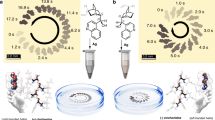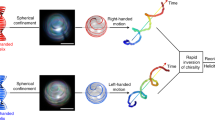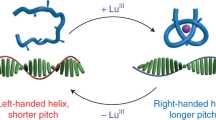Abstract
Successful attempts to manufacture synthetic molecular motors have recently been reported1,2. However, compared with natural systems such as motor proteins3,4,5,6, synthetic motors are smaller molecules and are therefore subject to thermal fluctuations that prevent them from performing any useful function7. A mechanism is needed to amplify the single molecular motion to such a level that it becomes distinguishable from the thermal background. Condensation of molecular motors into soft ordered phases (such as liquid crystals) will be a feasible approach, because there is evidence that they support molecularly driven non-equilibrium motions8,9,10. Here we show that a chiral liquid-crystalline monolayer spread on a glycerol surface acts as a condensed layer of molecular rotors, which undergo a coherent molecular precession driven by the transmembrane transfer of water molecules. Composed of simple rod-like molecules with chiral propellers, the monolayer exhibits a spatiotemporal pattern in molecular orientations that closely resembles 'target patterns' in Belousov–Zhabotinsky reactions11. Inversion of either the molecular chirality or the transfer direction of water molecules reverses the rotation direction associated with switching from expanding to converging target patterns. Endowed only with the soft directional order, the liquid crystal is an optimal medium that helps molecular motors to manifest their individual motions collectively.
This is a preview of subscription content, access via your institution
Access options
Subscribe to this journal
Receive 12 print issues and online access
$259.00 per year
only $21.58 per issue
Buy this article
- Purchase on Springer Link
- Instant access to full article PDF
Prices may be subject to local taxes which are calculated during checkout




Similar content being viewed by others
References
Kelly, T.R., De Silva, H. & Silva, R.A. Unidirectional rotary motion in a molecular system. Nature 401, 150–152 (1999).
Koumura, N., Zijlstra, R.W.J., van Delden, R.A., Harada, N. & Feringa, B.L. Light-driven monodirectional molecular rotor. Nature 401, 152–155 (1999).
Berg, H.C. Molecular motors: Keeping up with the F1-ATPase. Nature 394, 324–325 (1998).
Geeves, M.A. Molecular motors: stretching the lever-arm theory. Nature 415, 129–131 (2002).
Vale, R.D. & Milligan, R.A. The way things move: Looking under the hood of molecular motor proteins. Science 288, 88–95 (2000).
Sharp, D.J., Rogers, G.C. & Scholey, J.M. Microtubuli motors in mitosis. Nature 407, 41–47 (2000).
Davis, A.P. Synthetic molecular motors. Nature 401, 120–121 (1999).
Tabe, Y. & Yokoyama, H. Two-dimensional dynamic patterns in illuminated Langmuir monolayers. Langmuir 11, 4609–4613 (1995).
Mikhailov, A.S. & Ertl, G. Nonequilibrium structures in condensed systems. Science 272, 1596–1597 (1996).
Palffy-Muhoray, P., Kosa, T. & Weinan, E. Brownian motors in the photoalignment of liquid crystals. Appl. Phys. A 75, 293–300 (2002).
Zhabotinski, A.M. & Zaikin, A.N. Concentration wave propagation in two-dimensional liquid-phase self-oscillating system. Nature 225, 535–536 (1970).
Hauck, G., Koswig H.D. & Labes, U. Electric-field-induced structure formation in free standing ferroelectric-films. Liq. Cryst. 14, 991–997 (1993).
Nasuno, S., Yoshino, N. & Kai, S. Structural transition and motion of domain-walls in liquid-crystals under a rotating magnetic-field. Phys. Rev. E 52, 1598–1601 (1995).
Galstyan, T.V. & Drnoyan, V. Light-driven molecular motor. Phys. Rev. Lett. 78, 2760–2763 (1997).
Lehmann, O. Structur, System und magnetisches Verhalten flüssiger Krystalle und deren Mischbarkeit mit Festen. Annln Phys. 2, 649–705 (1900).
Madhusudana, N.V. & Pratibha, R. An experimental investigation of electromechanical coupling in cholesteric liquid crystals. Liq. Cryst. 5, 1827–1840 (1989).
Lagerwall, S.T. in Handbook of Liquid Crystals Vol. 2B (eds Demus, D., Goodby, J., Gray, G. W., Spiess, H.-W. & Vill, V.) Ch. VI (Wiley–VCH, Weinheim, 1998).
Meyer, R.B., Liebert, L., Strzelecki, L. & Keller, P. Ferroelectric liquid crystals. J. Phys. 36, L69–L71 (1975).
Tabe, Y. et al. Can hydrophobic oils spread on water as condensed Langmuir monolayers? J. Phys. Chem. 106, 12089–12093 (2002).
Tabe, Y. & Yokoyama, H. Fresnel formula for optically anisotropic Langmuir monolayers: An application to Brewster angle microscopy. Langmuir 11, 699–704 (1995).
de Gennes, P.G. & Prost, J. The Physics of Liquid Crystals (Oxford Univ. Press, 1993).
Prigogine, I. Introduction to Thermodynamics of Irreversible Processes (Wiley, New York, 1967).
Acknowledgements
We thank J. Li, Clariant Japan and S. Naemura, Merck, Japan for generous provision of the LC compounds.
Author information
Authors and Affiliations
Ethics declarations
Competing interests
The authors declare no competing financial interests.
Supplementary information
41563_2003_BFnmat1017_MOESM1_ESM.mov
The real-time movie of the CW molecular rotation in (R)-OPOB monolayer on pure glycerol at 45% RH and room temperature. (MOV 982 kb)
Rights and permissions
About this article
Cite this article
Tabe, Y., Yokoyama, H. Coherent collective precession of molecular rotors with chiral propellers. Nature Mater 2, 806–809 (2003). https://doi.org/10.1038/nmat1017
Received:
Accepted:
Published:
Issue Date:
DOI: https://doi.org/10.1038/nmat1017
This article is cited by
-
Rotation and transportation of liquid crystal droplets for visualizing electric properties of microstructured electrodes
Scientific Reports (2023)
-
Temperature gradient sensing mechanism using liquid crystal droplets with 0.1-mK-level detection accuracy and high spatial resolution
Scientific Reports (2022)
-
Differential rotation in cholesteric pillars under a temperature gradient
Scientific Reports (2020)
-
Giant anisotropic thermal expansion actuated by thermodynamically assisted reorientation of imidazoliums in a single crystal
Nature Communications (2019)
-
Topology-dependent self-structure mediation and efficient energy conversion in heat-flux-driven rotors of cholesteric droplets
Nature Communications (2018)



